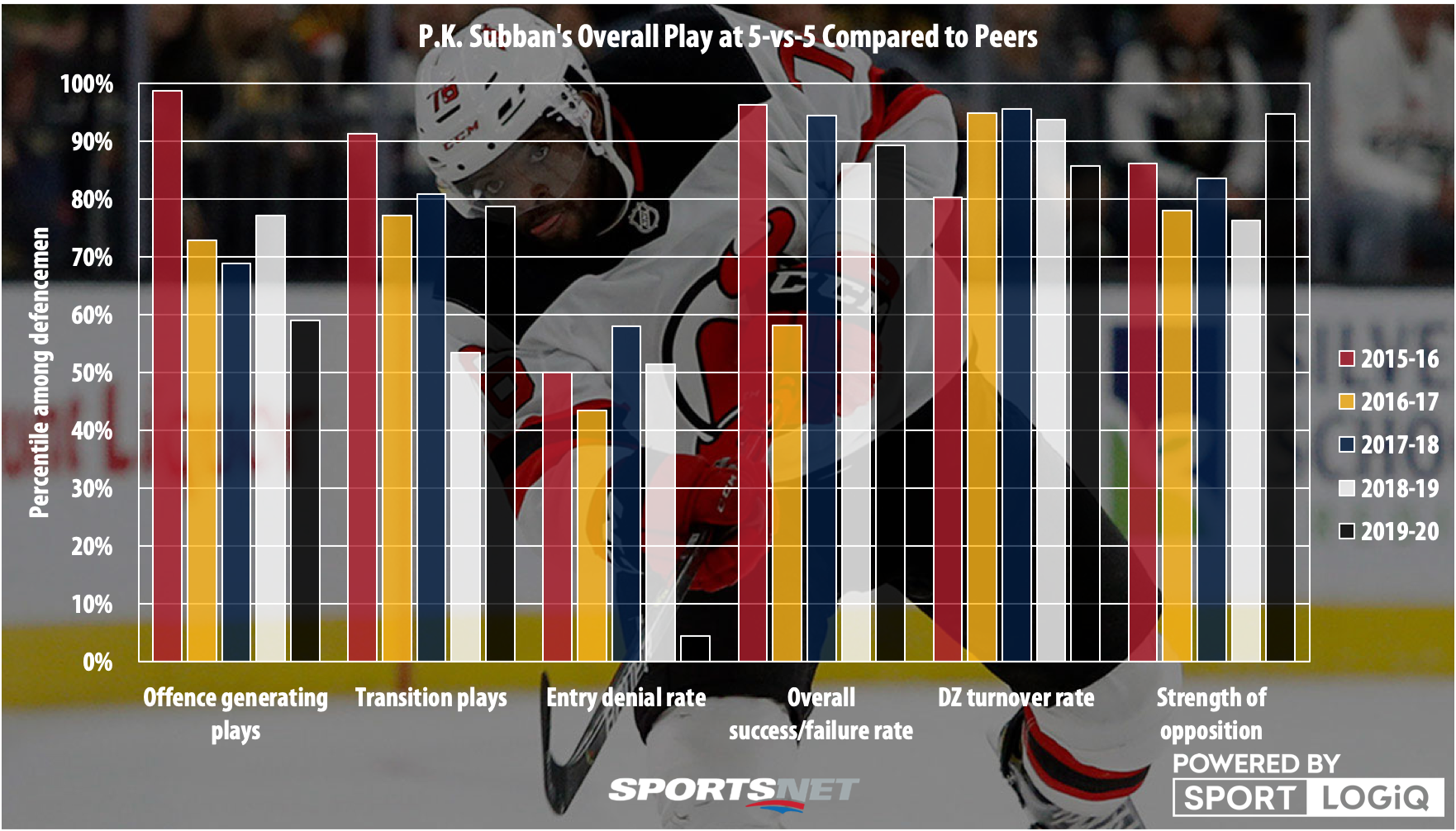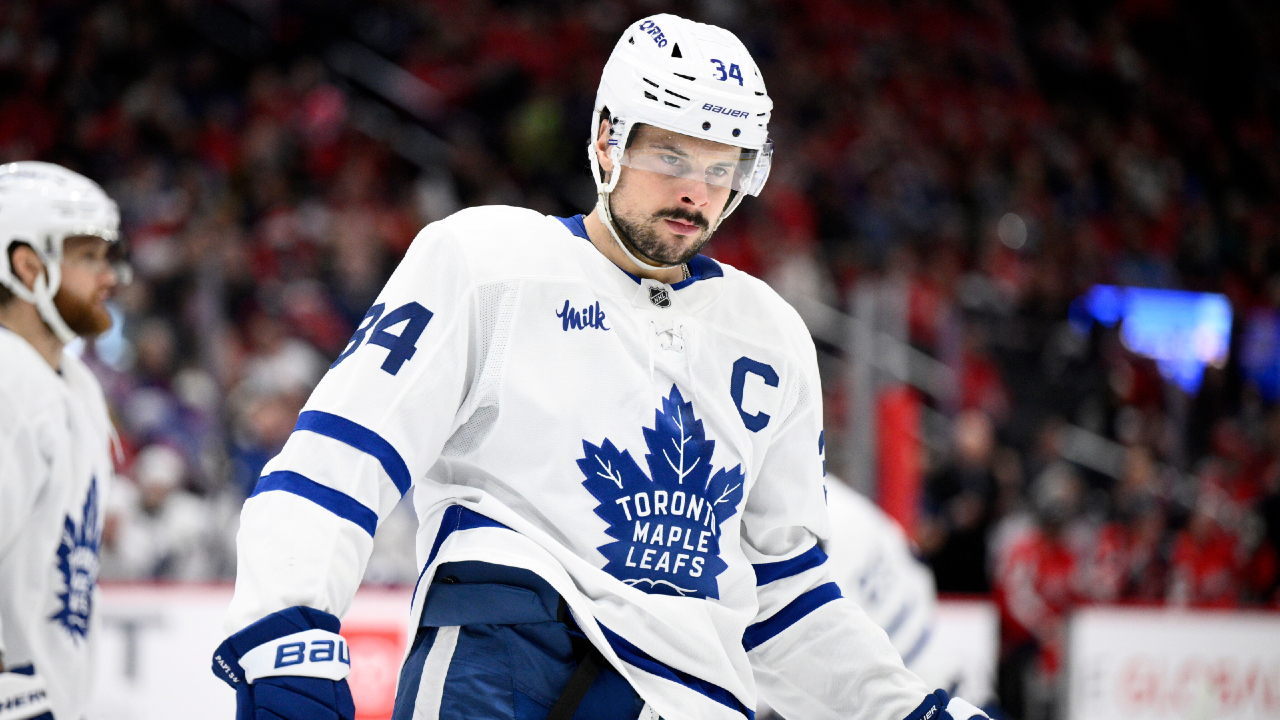
In last week’s analytics mailbag, I mentioned that I got a lot of questions about P.K. Subban. It’s probably a little fortunate for Subban that he’s been in a smaller market like New Jersey this season, because outside of Montreal Canadiens fans who either still love him or want to relitigate the trade that sent him to Nashville, there hasn’t been too much attention on a disastrous season for him.
I touched on Subban’s season back in early December in a piece on the players who had been most unlucky at that point in the season, and it’s true that a big part of what ailed Subban’s surface-level numbers was about on-ice percentages more than individual performance, but that doesn’t mean that nothing was wrong.
In order to see what, if anything, has changed in Subban’s game, let’s look at the broad strokes and compare him to his peers in league ranks, expressed as percentiles. What this means if you’re unfamiliar is that if a player ranks in the 99th percentile in a specific statistic, they are within the top one per cent of all players in their position in that statistic.
With SPORTLOGiQ data we can reach back five years into the past to Subban’s final season with the Canadiens, and contrast each of the following seasons.

There are some areas where Subban hasn’t really fallen off compared to his past self, like his overall success or failure rate on plays — which measures both volume of plays a player is involved in and how often they are successful in their attempts — along with maintaining a very strong defensive-zone-turnover rate compared to his peers, even before adjusting for team structure, which usually rockets Subban up the rankings even more.
Then there are the areas which are a bit more obvious to the eye, like Subban going from the 99th percentile in offence-generating plays in his last season in Montreal down to around 70th for the following three seasons in Nashville, down to below 60th this season. Those are steep drops in offensive contributions.
The drop upon landing in Nashville is probably partly due to joining a team that already had Roman Josi there as the primary offensive contributor from the back end, forcing Subban to take a decidedly less-risky approach to his game, which is reflected in going from the 80th percentile in defensive-zone-turnover rate to an average of 95th percentile while in Nashville.
Subban went from a wheeling and dealing risk taker, who was still excellent with the puck but also prone to some pretty big turnovers, to a lock-it-down defender who also managed to produce a strong amount of offence. It was a stylistic change that didn’t really mark a drop-off in his game overall for the first couple of seasons, despite some struggles in the first year during the regular season, and even led to a Norris Trophy nomination in 2017-18.
Last season however, he saw a gigantic drop in his ability to move the puck, down to the 53rd percentile in transition plays, barely above an average defenceman, despite his strength of opposition dropping a little.
This season has actually seen a return to form in moving the puck, with Subban back to approaching the 80th percentile there, but with his offence dropping off significantly it’s clear that most of his involvement isn’t showing up in the offensive zone.
At the same time, Subban has seen the highest strength of opposition of his career, while seeing more defensive struggles than he’s ever dealt with before. In the past, Subban was about average at defending his own blue line, while this season he’s in the bottom 4.5 per cent of all defencemen in denying entries into his defensive zone. That porous defence at the blueline has cascaded into other problems, which has resulted in Subban posting among the worst on-ice slot-passes-against per 20 minutes in the league.
In terms of shots, he’s still posting very strong numbers relative to his teammates, but the passes have been a big issue for him, so the shots against that do happen while he’s on the ice end up being far more dangerous than most. That isn’t typical for Subban either, who usually posts strong numbers in that area.
However, the number of slot passes against a player is on the ice for is highly correlated with the strength of opposition they face, so some of his struggles there can be attributed to tougher minutes with weaker teammates, but obviously not all.
The porous defence and lack of offence has sort of reduced Subban to a high level transition player this season — if you read any of the top-20 player rankings by position I used to do, you would know transition was Subban’s weakest area over the last few seasons overall. The biggest reason for that has always been his reliance on dumping the puck out of the defensive zone instead of making a controlled play, but still it was the offensive and defensive zones that he exerted most of his impact in his prime.
Turning 31 in mid-May, decline is the normal pattern for a defenceman Subban’s age, but that doesn’t mean a player is no longer effective. Mike Green, for example, hasn’t been anywhere near what he was for the Washington Capitals in his prime, but has been an excellent defenceman into his mid-30s, still a decent No. 2 on a lot of teams at this point despite his offensive game evaporating.
Subban’s decline does seem rapid the last two years though, with steep drop-offs in specific areas that should be a little jarring to anyone who saw him in his prime. The cause behind those struggles has been speculated about for years with well-known issues with his back, and I do wonder if he ever fully recovered from that collision with Alexei Emelin on his last shift with the Montreal Canadiens.
The time where Subban was among the super elite defencemen in the NHL is likely over, but as he recovered his transition game this year following a steep drop-off last season, I don’t think I would throw in the towel on him finding ways to adapt and get other areas of his game back to a reasonable area.
If the back issues are the reason behind it all, perhaps this extended time off caused by the global pandemic we’re all mired in will be a blessing in disguise for the charismatic defenceman




